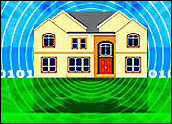
Wiring your home for multimedia? Dreaming about it?
Even if you’re using an electrician to pull the CAT 5e cable, it’s worth getting involved in the design of the termination — the rack. The rack is the centralized point within the home where the wiring meets switches, router and so on.
The rack will be around a lot longer than the electrician, and you need it to last. “Lasting” in this sense means future-proofing it — making sure it can handle your upgrades and technology changes down the road.
I was recently involved in a project like this. This is what I learned.
Step 1
Determine the rack location based on convenience and available space. All of the interior wiring — CAT 5e for networks and coax for television — joins to that one location.
Why television too, you may ask? Well, it’s because you can run Internet on coax if you have too. If you run out of capacity on the CAT 5e runs in a few years — for streaming media devices, for example — you’ll be able cannibalize the then likely archaic cable TV runs without chopping into walls.
Step 2
Plan for heat buildup. In most installations, the utility closet, complete with home heating and hot water system, will be the most convenient place for the rack. Heat and electronics don’t mix.
Buy two rack-mount cooling fans. Install one at the bottom of the rack and one at the top. This will circulate air. You can mount them upside-down too if you want.
Tip: Standard racks are 19 inches wide. Rack height is measured in Rack Units or “U.”
A 16U rack is about waist high and will hold two fans, a phone switch, a network switch, a patch panel, and a shelf for your paperwork.
Open-sided racks are cheaper than those with walls and allow for ventilation. Vented rack shelves allow for air circulation.
Step 3
Purchase standard 19-inch racks and rack parts. Rack elements, like switches, can be measured in Us. For example, a fan can be 1U deep.
One U covers three mounting cage nut holes on the vertical edges of the front of the rack.
A rack-mountable Netgear 16-port ProSafe Gigabit network switch is 1U deep; a Belkin 48-port CAT 5e Patch Panel is 2Us.
The patch panel is the switchboard-like panel where network connections come in from the rooms to be distributed to the network switch.
Allow for at least one mounting cage-nut hole between rack mounted gear for ventilation, and to run cables from the fascia to the back of the rack-connecting network switch to router modem, for example.
Step 4
Choose the equipment. Select Gigabit switches rather than 10/100 or other speeds.
Gigabit is faster, and even if your network equipment isn’t taking advantage of Gigabit right now, it likely will in the future as multimedia becomes more prevalent.
Angled patch panels are easier to work on.
Step 5
Plan the layout of the rack by installing the patch panel in the vertical middle of the rack.
The CAT 5e runs from the rooms terminate on the patch panel. Ensure the electrician leaves long loops of cable rather than cutting the incoming cables too short — long loops are the mark of a considerate pro because it’s easier for the next person to work on the installation.
Step 6
Install the telephone switch and network switch in the rack with the patch panel between them.
Configuring the patch panel in the middle of the switches like that allows 0.25m patch leads run to either switch from the patch panel without excessive ungainly crossing, or being too short. You still may need a few 0.5m leads for the rack edges though.
Tip: Order a 50-pack of rack cage nuts, bolts and washers. Some of the mountable gear doesn’t ship with fasteners.
Step 7
Document what you’re doing.
Ports on the patch panel are usually labeled. For example, a 48-port CAT 5e panel will have ports labeled from 1 to 48. Insist that the room jacks which correspond to the patch panel ports are labeled too.
For example, if a bedroom CAT 5e run terminates at the port labeled “1” on the patch panel, create a naming convention, and permanently label the jack in the bedroom as “C1”, or whatever, with a labeling machine.
Maintain a network spreadsheet master list as you add gear.
Spreadsheet columns can be labeled “Location,” where in this case that would be “Bedroom.” Then “Jack” in this case “C1” and then “Device” — say, a streaming media player.
Add other optional columns to the list, like the color of the patch lead you use to connect the patch panel to the switch.
There isn’t a common convention for patch lead colors. I used blue for network patch leads, green for digital phone connections, orange for analog phone like fax, and red for phone line.
This level of documentation is easy to do and makes life easier, and it’s cheaper in the case of any electrician working on the rack — they don’t have to trace everything back before starting the job.
Step 8
Enforce documentation. This is important throughout then life of the rack. Family members mustn’t make haphazard configuration changes without noting what they’ve done:
“Oh sorry, I just removed something (your Internet radio) to plug in my new gaming console — forgot to put it back,” and so on.
Buy a 1U shelf specifically to hold this paperwork.





















































